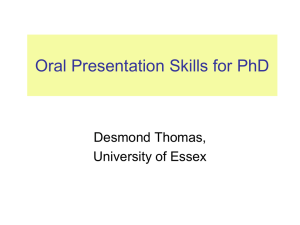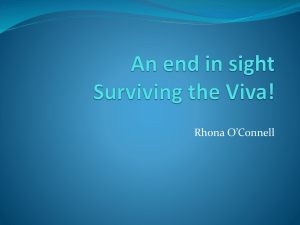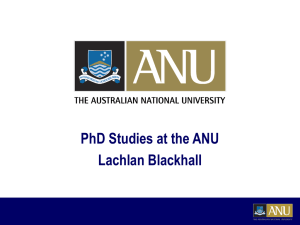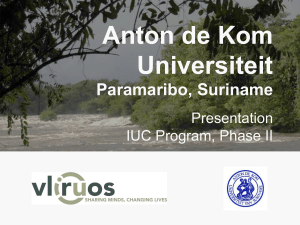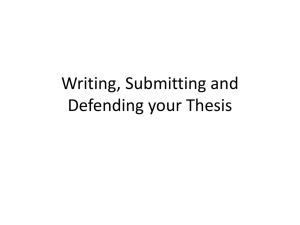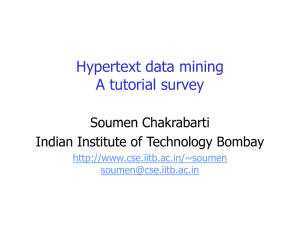Community Consciousness, Development, Leadership: The
advertisement
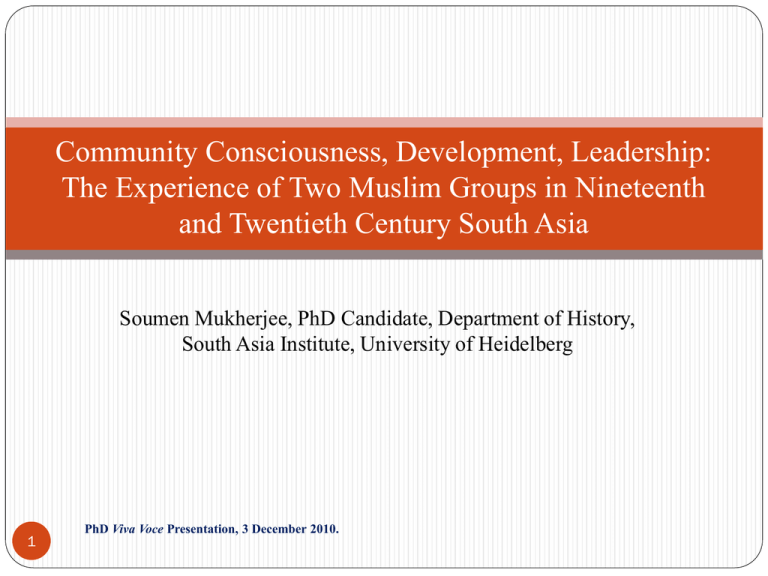
Community Consciousness, Development, Leadership: The Experience of Two Muslim Groups in Nineteenth and Twentieth Century South Asia Soumen Mukherjee, PhD Candidate, Department of History, South Asia Institute, University of Heidelberg 1 PhD Viva Voce Presentation, 3 December 2010. 1. The Background: 1.1 ‘Living together separately’ – a welcome addition to existing paradigms on interactions of Islamic and non-Islamic cultures in South Asia. But gap in understanding: 1.1.1 When and how do individuals and/ or communities: a) live together; b) live separately; and c) live together in certain respects while separately in certain others. 1.1.2 The examples of the two Shia sub-sects of the Khojas and the Daudi Bohras in the 19th and 20th century South Asia, or more precisely Bombay. 1.1.3 The core questions in this study rest not on the broader problem of interaction between Islamic and non-Islamic history and culture, but between different strands and sectarian traditions within the rubric of Islam which, in turn, show the plurality of voices within Islam. 2 Soumen Mukherjee, PhD Viva Voce Presentation, 3 December 2010. 2. The Core Questions, or, ‘What is/ are new’: 2.1 The misleading idea of a monolithic Muslim community (cf. the Brass-Robinson debate). The diverse sectarian and sub-sectarian traditions within Islam constitute the case in point. 2.2 Nature of the present project: a comparative, and in certain respects contrastive, study of the two subsects of the Daudi Bohras and the Khojas – and perhaps also the first of its kind. 2.3 Community consciousness, development and leadership – three inter-related aspects of a bigger problem: 3 Soumen Mukherjee, PhD Viva Voce Presentation, 3 December 2010. 2. The Core new’(contd.): Questions, or, ‘What is/ are that the socio-religious and political leaders of these two sub-sects faced in forging of linkages with (as well as distance from) the broader Muslim community of South Asia. 2.4 The sites of negotiations: • politics, • socio-religious reformism, amounting to welfarist and developmental concerns. Existing academic works have their own inadequacies, such as: 2.4.1 Inadequacies in Existing Literature: The Case of the Daudis: o Wright Jr.- Explicates the coexistence of the ‘traditional’ and the ‘modern’, though the ‘competitive modernization’ thesis limited within the sphere of political development. . 4 Soumen Mukherjee, PhD Viva Voce Presentation, 3 December 2010. 2. The Core Questions, or, ‘What is/ are new’ (contd.): o Roy- Sees, rather naively, the Udaipur riots of the 1970s as the first signs of the Daudis’ quest to understand ‘their religious system’. o Blank- Explores the roots of the coexistence of the ‘traditional’ and the ‘modern’, but reduces the later 20th century reformist venture to the status of a dissident movement, dismissing the moral claims of the reformists 2.4.2 Inadequacies in Existing Literature: The Case of the Khojas: o Papanek- Emphasis on the didactic role of the Aga Khans, but not so much on the 19th century historical backdrop. o Masselos- His understanding of conceptual categories of ‘modernisation’ and ‘orthodoxy’ contestable. The reformist Khojas’ modernisation project and claims of Sunni-hood are seen as ‘paradoxical’. o Sodhan- Transformation of a socio-religious polity with its own customary laws to a clearly defined ‘sect’ became possible, thanks to the emphasis on the rhetoric of ‘public issues’, though predicaments of the leadership and the modalities of its working largely unappreciated. 5 Soumen Mukherjee, PhD Viva Voce Presentation, 3 December 2010. 2. The Core Questions, or, ‘What is/ are new’ (contd.): o Purohit- The canonisation of the Ginan literature – the panth tradition, as opposed to ‘Ismaili’, but inadequate treatment of the socio-political forces. 2.4 The balancing of sectarian or sub-sectarian specificities with the general trend of standardisation of religious norms in the later 19th century – the backdrop of competing strands of religious nationalist politics from later part of the 19th century in South Asia. 2.5 The current project : 6 • is located at the intersection of social, political and religious experience of the two sub-sects • problematises the question of leadership, engages with a comparative historical study of social reformism of these two groups, and • explicates the political and social ramifications of the processes, and the idioms resorted to in the diverse social, political and religious negotiations. Soumen Mukherjee, PhD Viva Voce Presentation, 3 December 2010. 3. Theoretical Considerations, Sources & Methods: 3.1 Interdisciplinary: drawing on theoretical considerations in social and intellectual history as well as some key paradigms in Political Science. 7 • Skinnerian contextualism: emphasis on languages and rhetoric. • The relevance of ‘public sphere’. • Historical contexts studied over a longue durée by employing the model of ‘path dependence’. • Religious attitudes deconstructed by employing, in a qualified way, the tool of rational choice theory of religion (RCTR); the over-emphasis on the ‘economic approach’ within RCTR underscored. • The underlying idea of ‘identification’ (as opposed to ‘identity’ per se; Stuart Hall) and a qualified use of ‘strategic syncretism’ to deconstruct the modalities of identification. Soumen Mukherjee, PhD Viva Voce Presentation, 3 December 2010 3. Theoretical Considerations, Sources & Methods (contd.): 3.2 Archival sources and interviews: 8 • The colonial archives, and beyond. • Newspaper reports. • Judgements of major law cases, and other associated papers, e.g. speech made by counsels. • Self-depicting literature (tracts and memoirs of communities’ religious and/ or political leaders). • Select interviews. Soumen Mukherjee, PhD Viva Voce Presentation, 3 December 2010 4. Research Design: Propositions made Chapter 4.1 Colonial understanding of the two liminal communities of the Bohras and the Khojas Chapter 2. Chapter 3 4.2 Mediated by interventions from sections of such communities in the legal space 4.3 Undermines much of the Saidian notion of alterity. 4.4 The competing approaches to define community boundaries, coming from within the Khoja community of colonial Bombay from c. mid-19th onwards 4.5 Inextricably tied up with broader reformist questions. 9 Soumen Mukherjee, PhD Viva Voce Presentation, 3 December 2010 4. Research Design (contd.): Propositions made Chapter 4.6 Reformist ventures internally diverse. Chapter 4 Chapter 5 4.7 Reformist-revitalistic trends celebrating essentially sectarian values (exemplified by Mulla Abdul Husain). 4.8 Decisive efforts to forge links with other Bohra groups (e.g., with the Sulaimanis) and even with South Asia’s Muslim population (exemplified by Adamjee Peerbhoy). 4.9 The Khoja leadership – represented by Aga Khan III – needs to be deconstruct- 10 Soumen Mukherjee, PhD Viva Voce Presentation, 3 December 2010 4. Research Design (contd.): Propositions made Chapter -ed at two levels: political and religious Chapter 5 Chapter 6 4.10 Aga Khan III’s political activism: interesting balance between sectarian specificities and political linkages with South Asia’s Muslim community. 4.11 Political activism and social reformist ventures are often closely intertwined. Aga Khan III’s example shows that the latter played a central role in sociopolitical policies. 4.12 Interestingly, the rhetoric welfarism, for him, was garbed in 11 Soumen Mukherjee, PhD Viva Voce Presentation, 3 December 2010 of 4. Research Design (contd.): Propositions made (non- Chapter 6 4.13 Developments in post-Independence South Asia: The highly organised welfarist schemes of Aga Khan III developed into the Aga Khan Development Network under Aga Khan IV engaging with diverse issues of a plural society: from education through sustainable development to health care. Chapter 7 certain non-denominational sectarian) language. 12 Chapter 4.14 The Daudi leadership, in contrast, is more preoccupied with issues of the individual vs. community, restricting its developmental agenda within the field of education. Soumen Mukherjee, PhD Viva Voce Presentation, 3 December 2010 5. Specific Findings & Generalisable Conclusions: Specific Findings Generalisable Conclusions Shifting nature of community The view of a monolithic Muslim consciousness of the Daudis and the Khojas – internal diversities: socio-religious structure is both similar to and different from each other, conditioning their social, religious and political experience. community in South Asia is historically unfounded. Sectarian and sub-sectarian traditions have to be given due importance, as well as their internal structural diversities. Reconfiguration of the boundaries of interstitial socioreligious groups into close-knit sub-sectarian tradition within Islam, albeit with some ambivalence and ambiguities. 13 Soumen Mukherjee, PhD Viva Voce Presentation, 3 December 2010 Importance of studying processes of negotiations, and ideational shifts in community consciousness, bringing into focus the process(es) of identification as opposed to ‘identity’ as such. 5. Specific Findings & Generalisable Conclusions (contd.): Specific Findings Generalisable Conclusions Importance of political and/ or The experience of modernism (or religious leadership in executing political activist as well as social welfarist policies. modernisation, as employed by Henri Lefebvre) and religious structures need not be mutually exclusive categories. Social welfarist and developmental concerns, sponsored by religious leaderships (e.g. Aga Khan III), as answer to reformist critiques of religious heads and related political predicaments. 14 Soumen Mukherjee, PhD Viva Voce Presentation, 3 December 2010 Social welfarist and developmental ideas and ventures are not far-fetched abstract categories, but have their own purpose as idioms of communication, negotiation and forging consensus. THE END
